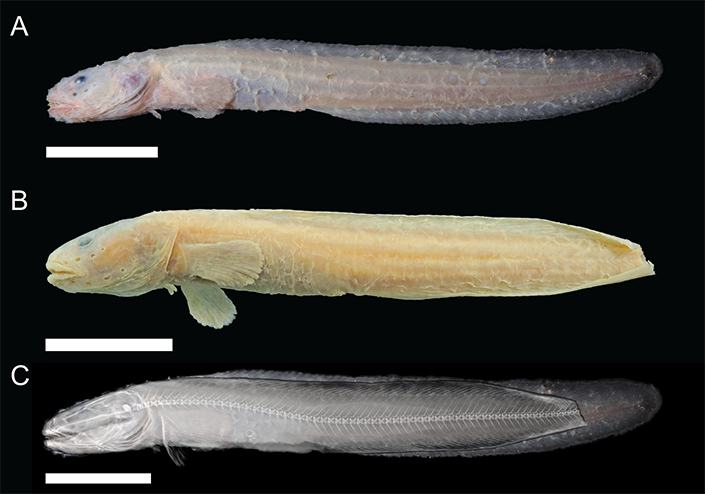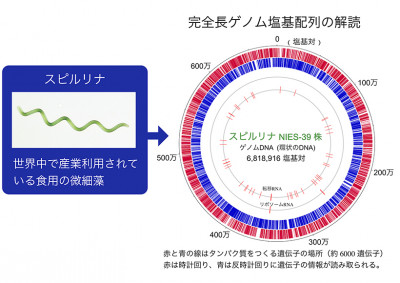深海の熱水噴出孔に生息するウナギの新種「Pyrolycus jaco」をスクリプス海洋研究所の研究者が解説 Scripps Oceanography researchers describe Pyrolycus jaco, a newly identified species of eelpout living in a hydrothermal seep in the deep ocean
2023-01-19 カリフォルニア大学サンディエゴ校(UCSD)

Museum specimens of Pyrolycus jaco showing this new species (A) freshly collected, (B) preserved, and (C) superimposed with a radiograph (X-ray) to study the skeleton. Photo credit: Ben Frable and Charlotte Seid, Scripps Institution of Oceanography
◆今回発見された「ピロリクス・ジャコ」は、コスタリカの太平洋岸にある「ジャコ・スカー」と呼ばれる熱水湧出域で発見された最初の魚類です。体長約15センチ、淡いピンクからラベンダー色のこのウナギのような小型の魚は、水深1,750~1,800メートルでチューブワームの間に寄り添っているのが観察されています。研究者らはこの新種について、1月19日発行の学術誌『Zootaxa』に論文を発表しています。
◆「コスタリカのハコというユニークな場所と都市にちなんで、ピロリクス・ジャコという名前をつけました」と、スクリプス海洋研究所の主執筆者ベン・フレブルは語っています。
◆ウナギは、エイヒレ科の魚で、特徴的なウナギの形をした体と、種によっては、口が「プッツン」したような表情をしていることから識別されます。ウナギの仲間は世界に約300種が知られており、カリフォルニア沖にも生息しています。このうち、熱水噴出孔やメタン湧出孔に生息するウナギは、太陽光の代わりに地殻の化学物質を利用する微生物によって支えられており、現在では13種が確認されています。
◆Pyrolycus jacoは、深海の周囲よりも数℃高い5.2℃の温度など、熱水噴出孔のような特徴を持つ極限環境であるジャコ・スカー・メタン湧出域で確認された最初のウナギウオーター種です。このわずかな違いが、近隣のメタン湧出域とは異なり、熱水噴出孔にしか生息しない特定の動物にとってジャコウスカーを天国にしているように見える。
◆この魚は、スクリップス海洋学研究所のリサ・レヴィン、グレッグ・ラウスらがコスタリカ大学と共同で、2009年に初めてハコスカー遺跡を発見した際に発見されたものです。ウッズホール海洋研究所のHOV(Human Occupied Vehicle)アルビンを使って、チューブワームの間を泳ぐ数匹のウナギを観察した。2019年にシュミット海洋研究所の遠隔操作車(ROV)SuBastianによる高解像度ビデオを含むその後の調査クルーズで、研究者はこのユニークな生態系の探索を続け、現在までにJacó Scarだけで24種の新しい無脊椎動物(ほとんどが小虫)を記載しています。
<関連情報>
- https://today.ucsd.edu/story/new-species-of-deep-sea-fish-discovered-off-costa-rica
- https://www.mapress.com/zt/article/view/zootaxa.5230.1.5
コスタリカ太平洋縁辺の熱水湧出域に生息するPyrolycus属の深海性ウナギの新種(Teleostei: Zoarcidae) A new deep-sea eelpout of the genus Pyrolycus (Teleostei: Zoarcidae) associated with a hydrothermal seep on the Pacific margin of Costa Rica
Benjamin W. Frable,Charlotte A. Seid,Alliosn W. Bronson,Peter Rask Moller
Zootaxa Published:2023-01-19
DOI: 10.11646/ZOOTAXA.5230.1.5
Abstract
A new species of the zoarcid genus Pyrolycus Machida & Hashimoto, 2002, Pyrolycus jaco sp. nov., is described from a hydrothermal seep environment named Jacó Scar in the eastern Pacific of Costa Rica. Four specimens were collected in 2018 between 1746–1795 m among tubeworm colonies around the seep. The new species is differentiated from its two western Pacific congeners by having a shorter head, snout, jaw, and pectoral fins. It is further diagnosed by having three postorbital pores and two occipital pores. Molecular sequences of the cytochrome c oxidase I gene are provided and are the first for the genus. The character states indicating miniaturization in this species are discussed. This is the first vertebrate species known from this composite reducing ecosystem and is the fourth hydrothermally-associated zoarcid from the eastern Pacific.


